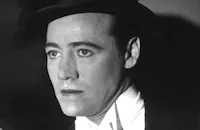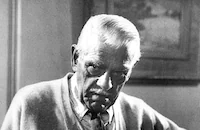The Guilty Generation

Brief Synopsis
Cast & Crew
Rowland V. Lee
Leo Carrillo
Constance Cummings
Robert Young
Leslie Fenton
Boris Karloff
Photos & Videos
Film Details
Technical Specs

Synopsis
A ruthless war takes place between the Palmero and Ricca gangs after the two leaders end a partnership. When two innocent children are killed in the conflict, the public outrcy forces the gang leaders to flee the city. The socially ambitious Mike Palmero goes to Florida, where he attempts to finesse his way into high society after becoming wealthy through bootlegging. He still surrounds himself with bodyguards and continues to run his gang, while Tony Ricca runs his operation from the outskirts of Chicago. Mike's beautiful daughter Maria, who has been reared in a French convent, loathes her father's underworld activities, even though she knows the money he earns from them will raise her to social prominence. Mike hires a publicity woman and invites the well-known people of the city to a party in order to get Maria's picture in the newspapers. At the party, Maria meets handsome architect Marco Smith, who is actually Tony's son. Marco has disowned his father, however, and assumed the name of Smith to distance himself from Tony's lifestyle. Maria and Marco fall in love, but Maria is afraid to tell her father for fear of feuling the Palmero-Ricca feud. As members of the gangs continue to kill one another, Mike orders the murder of Benedicto, Tony's favorite son. Tony retaliates by having Maria's brother Joe killed in a hail of machine gun fire. While dying, Joe informs his father that Marco is also a Ricca. Meanwhile, Marco and Maria have eloped, and they return to tell her father. Mike plans to kill Marco but delays the murder in order to torture him with anxiety. Maria's grandmother Nina helps Marco escape, however, and kills her son rather than allow him to order the execution of Marco and Maria. The young lovers are thus free to build a new life together, while the rival gangs dwindle under the attrition of constant reprisals.

Director
Rowland V. Lee
Cast

Leo Carrillo

Constance Cummings

Robert Young

Leslie Fenton

Boris Karloff
Emma Dunn
Jimmy Wilcox
Elliott Rothe
Phil Tead
Frederic Howard
Eddie Boland
William J. O'brien
Ruth Warren
Murray Kinnell
Crew

Photo Collections
Film Details
Technical Specs

Articles
The Guilty Generation
The Guilty Generation is often called a Romeo and Juliet story, and that's a good shorthand description. The nub of the picture is the blooming romance of two doe-eyed lovers, Maria Palmero (Cummings) and Marco Ricca (Robert Young), whose families are gangland clans engaged in a deadly feud with a steadily escalating body count. Even unlucky children have been gunned down in the crossfire.
The first key character we meet is Marco, a rising New York architect who has staved off questions about his background by changing his name. Now known to everyone as John Smith - not a very imaginative pseudonym, but it's getting the job done - he's a rising young architect with a growing New York practice. We learn his true identity when his father, Tony Ricca, visits his office, hoping to set up some sort of enterprise (probably crooked) that will benefit them both.
Marco wants nothing to do with his dad, and any doubts we might have about Tony's evil nature are settled by the fact that he's played by Boris Karloff, whose star-making performance in James Whale's frightening Frankenstein reached the screen just two weeks after this picture premiered. Before long we also meet Maria's father, Mike Palmero, played by Leo Carrillo, the top-billed star of The Guilty Generation.>br>
With the police and the public increasingly outraged about the mayhem they're causing, each family patriarch moves his base of operations to a new location. Tony sets up shop in Chicago while Mike takes refuge in Florida, where Marco has gone to work on a new building project. Mike has always harbored social ambitions, and at his new Florida estate he throws a fabulous party aimed at impressing the locals with his wealth and power, and also at encouraging the area's well-heeled young men to court his lovely daughter. He even hires a publicist, Ruth Warren (Nellie Weaver), to assist with the latter task. Maria was raised in a convent and dislikes her father's mobster lifestyle as thoroughly as Marco hates his dad's chosen livelihood. But loyalty to her family keeps her within Mike's household and sphere of influence.
The gala party turns into a gala disaster when Maria's most dissolute brother, Joe (Leslie Fenton), gets drunk, pushes elegantly clothed guests into the swimming pool, and starts waving a gun around. But by this time Maria and Marco have met, chatted, and felt their hearts begin to melt. Hiding their relationship from Mike, they decide to elope and live in Europe forever after. The family feud is still going strong, however, and the consequences are enormous when their secret ultimately comes out. Only a film released before the full advent of Production Code censorship could have pitted father against daughter and mother against son as savagely as this picture does in its final scenes.
Cummings had hung out with screen gangsters since the start of her screen career. Samuel Goldwyn brought the twenty-year-old stage actress to Hollywood in 1930 for a costarring role in a Ronald Colman picture, from which she was dropped because her voice sounded too American to suit the movie's British setting. Columbia Pictures promptly gave the MGM reject a contract and a part, casting her as a prison warden's innocent daughter in Howard Hawks's crime drama The Criminal Code (1931), where Karloff also gave a career-boosting performance. Cummings's showing was so strong that Columbia put her into a steady stream of solid roles through the latter part of 1932, when she started migrating to Paramount and other studios as a freelance actress.
Although her early Columbia films tended to be modest productions, Cummings received a terrific showcase in Frank Capra's sociopolitical romp American Madness (1932), a sort of dry run for his 1946 classic It's a Wonderful Life. She left her native country for England in 1935, bidding farewell to Hollywood with Whale's comic mystery Remember Last Night?. Her costar there was none other than Young, the ideally cast "juvenile" of The Guilty Generation. She resumed her busy stage work in Britain while remaining active in movies and eventually television as well.
Cummings's success on both sides of the Atlantic was facilitated by her early mentor and longtime husband Benn W. Levy, who was a prolific playwright and occasional screenwriter before serving as a leftwing member of Parliament in the post-World War II years. Cummings continued her stage activities through the very end of the twentieth century, counting important American works - including Eugene O'Neill's Long Day's Journey Into Night, Arthur Kopit's Wings, and Edward Albee's Who's Afraid of Virginia Woolf? - among her many credits.
The Guilty Generation is itself based on a play, but director Rowland V. Lee and adapter Jack Cunningham make it crisply cinematic, helped by Byron Haskin's unassuming camerawork, which makes good visual use of the Palmero family's sumptuous swimming pool, sweeping marble staircase, and generally ostentatious surroundings. It's fun to watch Carrillo - also a successful stage actor before his 1929 feature-film debut - portray the self-deluding Mike, lording it over a mostly odious clan like an instantly obsolete prototype of Marlon Brando's godfather. It's amusing to hear Karloff try to twist his refined English enunciation into something at least a tiny bit like a Sicilian accent. But most of all it's marvelous to watch Cummings make the most of a small but significant opportunity at the outset of her Hollywood period. She was definitely a film star who could act.
Director: Rowland V. Lee
Producer: Harry Cohn
Screenplay: Jack Cunningham; from the play by Jo Milward and J. Kirby Hawks
Cinematographer: Byron Haskin
Film Editing: Otis Garrett
With: Leo Carrillo (Mike Palmero), Constance Cummings (Maria Palmero), Robert Young (Marco Ricca), Leslie Fenton (Joe Palmero), Boris Karloff (Tony Ricca), Emma Dunn (Nina Palmero), Jimmy Wilcox (Don Morley), Elliott Rothe (Benedicto Ricca), Phil Tead (Skid), Frederick Howard (Bradley), Eddie Boland (Willie), William H. O'Brien (Victor), Ruth Warren (Nellie Weaver)
BW-82m.
by David Sterritt

The Guilty Generation
Quotes
Trivia
Notes
According to the Variety review, the scenes set in Florida and Leo Carrillo's Italian dialect suggest a comparison between the character "Mike Palmero" and to real life gangster Al Capone.

Miscellaneous Notes
Released in United States 1931
Released in United States 1931













